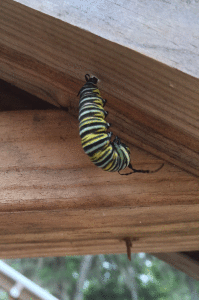
A Monarch caterpillar hangs upside down in order to form its chrysalis. Photo by Gulf Coast Bird Observatory
Butterflies are some of the most beloved insects that you can find in a garden. But their younger forms, the caterpillars, tend to go unappreciated by most. They’re often viewed as pests, unwelcome visitors who munch through leaves and fruits that the gardener wanted to preserve. But if we look closer, it becomes clear that caterpillars are some of the most valuable members of the ecosystem!
Caterpillars are incredibly important prey for spiders, mammals, other insects, and especially birds. Many adult birds eat caterpillars as part of their normal diet, but caterpillars are particularly crucial for baby birds, who are often wholly dependent on them for food. Caterpillars have a higher amount of protein and fat than other insects, helping the chicks grow up quickly.
For example, Carolina Chickadee adults eat a variety of seeds and insects, but their babies eat almost exclusively caterpillars. According to a recent study, a single nest of Chickadee chicks eats between 6,000-9,000 caterpillars in a single season. That’s a ton of caterpillars required to feed just a few babies. And if there aren’t enough caterpillars around, the chicks go hungry.
Fortunately, adult female butterflies are capable of laying hundreds of eggs. If a butterfly can manage to find a plant (sometimes of a very specific species) in a safe area with no pesticides, hundreds of caterpillars will emerge. Most of them will contribute to the food chain, and a few of them will grow up into butterflies. But as you might imagine, it can be hard for a mother butterfly to find the right conditions in the developed world we live in. Finding a plant of the correct species without pesticides can be a tall order for these little creatures.
To help butterflies and caterpillars, there are a few things that you can do. First, avoid using pesticides. They are almost always detrimental to caterpillars and butterflies. Second, plant native plants. Butterflies are specially adapted to the plants native to their area, and are usually unable to use exotic/introduced plants. For example, in a Texas garden, a Sawtooth Oak from Asia would be able to support only one species of caterpillar. But in that same garden, a native White Oak would be able to support up to 134 species of caterpillars!
